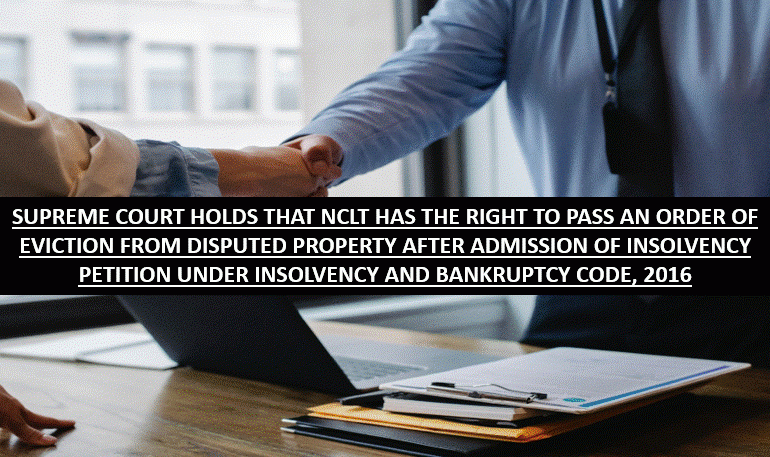SUPREME COURT HOLDS THAT NCLT HAS THE RIGHT TO PASS AN ORDER OF EVICTION FROM DISPUTED PROPERTY AFTER ADMISSION OF INSOLVENCY PETITION UNDER INSOLVENCY AND BANKRUPTCY CODE, 2016
In a recent case of Victory Iron Works Ltd. Vs Jitendra Lohia and Anr, Civil Appeal No 1743 of 2021 with Civil Appeal No 1782 of 2021, decided on 14.03.2023, a Two Judge Bench of the Supreme Court comprising of Justice Ramasubramanian and Justice Pankaj Mittal passed a Judgment protecting the rights of the Corporate Debtor in immovable property.
Parties to the Litigation:
The subject matter in dispute is a 10.19-acre (Property) land situated at Ramrajatala Station Road, Howrah, West Bengal.
i) M/s Energy Properties Private Limited (Appellant) in CA No.1782 of 2021 is the ostensible owner of the said Property, in whose name the title stands.
ii) Avani Towers Private Limited has financed the purchase of the said Property by a sum of Rupees 12 Crores to Energy Properties. It holds 40% of the share capital in Energy Properties, apart from holding a Joint Development Agreement with Energy Properties in respect of the Property in question.
iii) M/s Victory Iron Works Ltd. (Appellant) in CA No.1743 of 2021 is the licensee of 10,000 sq. ft. of the said Property by the Leave and License Agreement dated 11.08.2021.
Facts:
(1) One M/s Sesa International Limited (Financial Creditor) filed an Application under Section 7 of the Insolvency and Bankruptcy Code, 2016 (IBC) initiating CIRP against Avani Towers Private Limited (Corporate Debtor) in the National Company Law Tribunal (NCLT). The Tribunal admitted the Application on 15.10.2019.
(2) A Resolution Professional appointed to represent the Corporate Debtor during the CIRP claimed that the developmental rights held by the Corporate Debtor in the disputed Property formed part of their intangible assets. Hence, they must be included in the Information Bulletin.
(3) During the CIRP, both Energy Properties (Ostensible Owner) and Victory Iron Works (Licensee) obstructed the process, whereby the Resolution Professional filed an Application, namely CA (IB) No.1807/KB/2019 (RP Application) before the Adjudicating Authority under IBC praying to grant possession of the Property to conduct the process without any interference. The said Application was allowed on 12.02.2020.
(4) This was strongly opposed before the NCLT by Energy Properties on the ground that the Property did not belong to the Corporate Debtor and therefore it must not be included under their assets.
(5) Victory Iron Works also opposed the Application on the ground that they were in possession of the entire Property partly by virtue of the Lease and License Agreement and partly by an Oral Agreement. Hence, the Authorities under IBC were not empowered to evict them from the said Property.
(6) NCLT held that the Property possessed (10,000 sq. ft.) by the Licensee would not be obstructed but the rest of the Property would be under CIRP.
(7) Aggrieved by this Order, both the Ostensible Owner and the Licensee appealed before NCLAT in two independent Appeals. The said Appeals were dismissed by NCLAT dated 08.04.2021. Although, NCLAT confirmed the protection of Property in possession of the Licensee and refused to acknowledge the Licensee’s possession of the entire Property.
(8) The parties appealed against the aforesaid Order dated 08.04.2021 of dismissal in the Supreme Court in CA No.1782 of 2021 and in CA No.1743 of 2021, where the following contentions were raised –
(i) The Ostensible Owner claims title of the said Property who purchased it from the Authorized Officer of UCO Bank under the Securitization and Reconstruction of Financial Assets and Enforcement of Security Interest Act, 2002, under a Sale Certificate dated 29.01.2008. Therefore, the Corporate Debtor is not to be treated the owner and the Property cannot be part of its assets.
(ii) The Licensee claims that, since the Ostensible Owner holds title of the said Property, it should not be part of the CIRP conducted against the Corporate Debtor as the Property belonged to a third party (Ostensible Owner).
Supreme Court Analysis:
- In light of all the contentions raised, the Hon’ble Supreme Court interpreted the definition of the word ‘Asset’. According to Section 102(2) of the Income Tax Act, 1961 the word ‘Asset’ was defined to include “property or right of any kind”. The Apex Court held that the definition throws light on the fact that property or right of any kind is an asset.
- Applying this definition to the current case, the rights of the Corporate Debtor on immovable properties, namely the disputed Property of 10.19-acres was decided.
- Referring to the documents in respect to the purchasing of land – Sale Deed, Development Agreement, Memorandum Recording Possession, Leave and License Agreement, the Hon’ble Court held that the bundle of rights and interests were clearly in favor of the Corporate Debtor, making the said Property fall under his assets.
- The Apex Court also held that the License Agreement was between the Corporate Debtor and the Licensee while the Ostensible Owner had merely confirmed the Agreement.
- The Apex Court further held that both, NCLT and NCLAT were right in protecting the rights of the Corporate Debtor possessing the Property and balancing it with the land possessed by the Licensee.
Conclusion:
The Hon’ble Supreme Court concluded the case, by dismissing the Appeals and upholding the impugned Orders by the Authorities that had directed Victory and Energy Properties from obstructing the possession and activities of the Resolution Professional and that the Order shall not affect the activities of Victory Iron Works Ltd. In the land possessed by them under the Leave and License Agreement dated 11.08.2011, until the original owner of the property decides further course of action as far as Leave and License Agreement is concerned.
Shalini Donthi
Legal Associate
The Indian Lawyer





































Leave a Reply